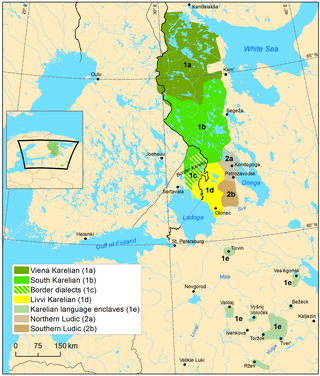You can help expand this article with text translated from the corresponding article in Finnish. (May 2021) Click [show] for important translation instructions.
|
| Livvi-Karelian | |
|---|---|
| Ливви | |
| Native to | Russia, Finland |
| Region | between Lake Ladoga and Lake Onega, northward of Svir River, Karelia |
Native speakers | 14,100–25,000 (2000–2010)[1] |
| Latin (Karelian alphabet) | |
| Official status | |
Recognised minority language in | |
| Language codes | |
| ISO 639-3 | olo |
| Glottolog | livv1243 |
| ELP | Livvi |
 | |
 Olonetsian is classified as Definitely Endangered by the UNESCO Atlas of the World's Languages in Danger (2010) | |
| People | Karelians |
|---|---|
| Language | Karelian; Livvi-Karelian |
| Country | Karelia |
Livvi-Karelian[6] (Alternate names: Liygi, Livvi, Livvikovian, Olonets, Southern Olonetsian, Karelian; Russian: ливвиковское наречие, romanized: livvikovskoye narechiye)[6][7] is a supradialect of Karelian, which is a Finnic language of the Uralic family,[8] spoken by Olonets Karelians (self-appellation livvi, livgilaizet), traditionally inhabiting the area between Ladoga and Onega lakes, northward of Svir River.
The name "Olonets Karelians" is derived from the territory inhabited, Olonets Krai, named after the town of Olonets, named after the Olonka River.
- ^ Karjalainen, Heini; Puura, Ulriikka; Grünthal, Riho; Kovaleva, Svetlana (2013). "Karelian in Russia. ELDIA Case-Specific Report". Studies in European Language Diversity. 26. ELDIA. ISSN 2192-2403.
- ^ Change in the regulation by the president of Finland about European Charter for Regional or Minority Languages, 27.11.2009 (in Finnish)
- ^ "Законодательные акты: О государственной поддержке карельского, вепсского и финского языков в Республике Карелия". Archived from the original on 11 October 2017. Retrieved 8 January 2011.
- ^ Rantanen, Timo; Tolvanen, Harri; Roose, Meeli; Ylikoski, Jussi; Vesakoski, Outi (8 June 2022). "Best practices for spatial language data harmonization, sharing and map creation—A case study of Uralic". PLOS ONE. 17 (6): e0269648. Bibcode:2022PLoSO..1769648R. doi:10.1371/journal.pone.0269648. PMC 9176854. PMID 35675367.
- ^ Rantanen, Timo, Vesakoski, Outi, Ylikoski, Jussi, & Tolvanen, Harri. (2021). Geographical database of the Uralic languages (v1.0) [Data set]. Zenodo. https://doi.org/10.5281/zenodo.4784188
- ^ a b "Livvi-Karelian". Ethnologue. Retrieved 28 May 2011.
- ^ Moseley, Christopher (2007). Encyclopedia of the world's endangered languages. Psychology Press. p. 263. ISBN 9780203645659.
- ^ "Language Family Trees, Uralic, Finnic". Ethnologue. Retrieved 28 May 2011.